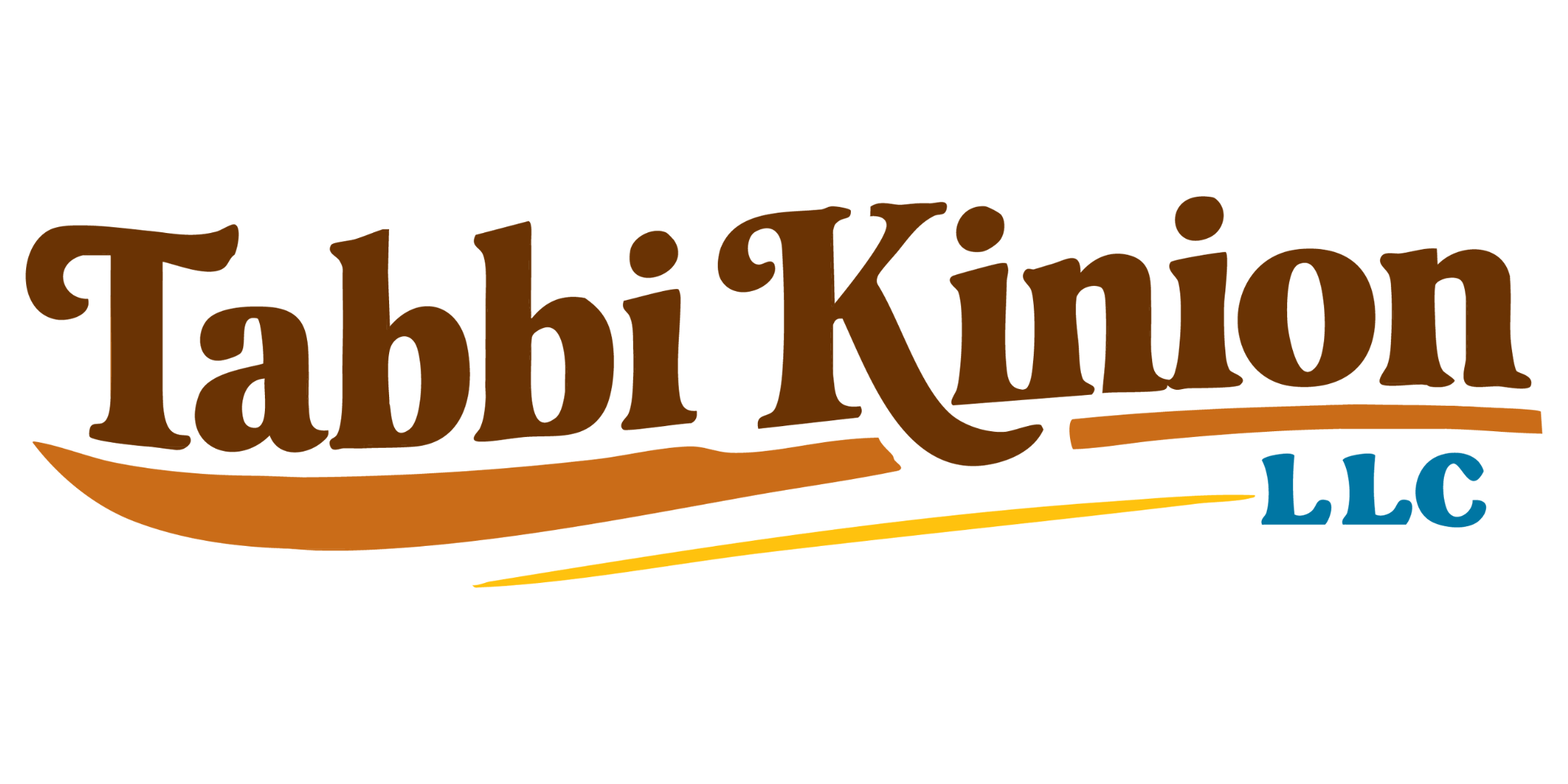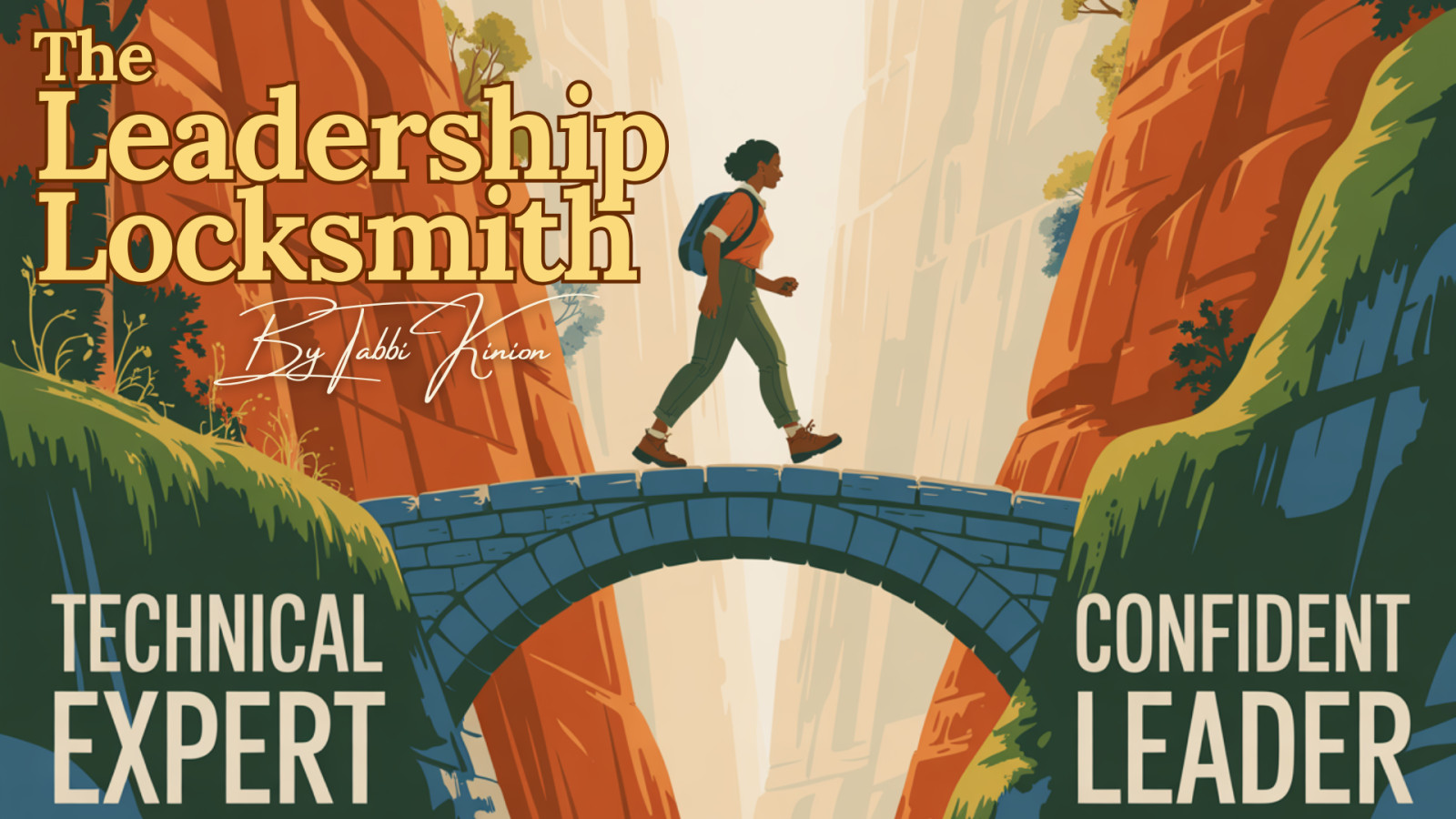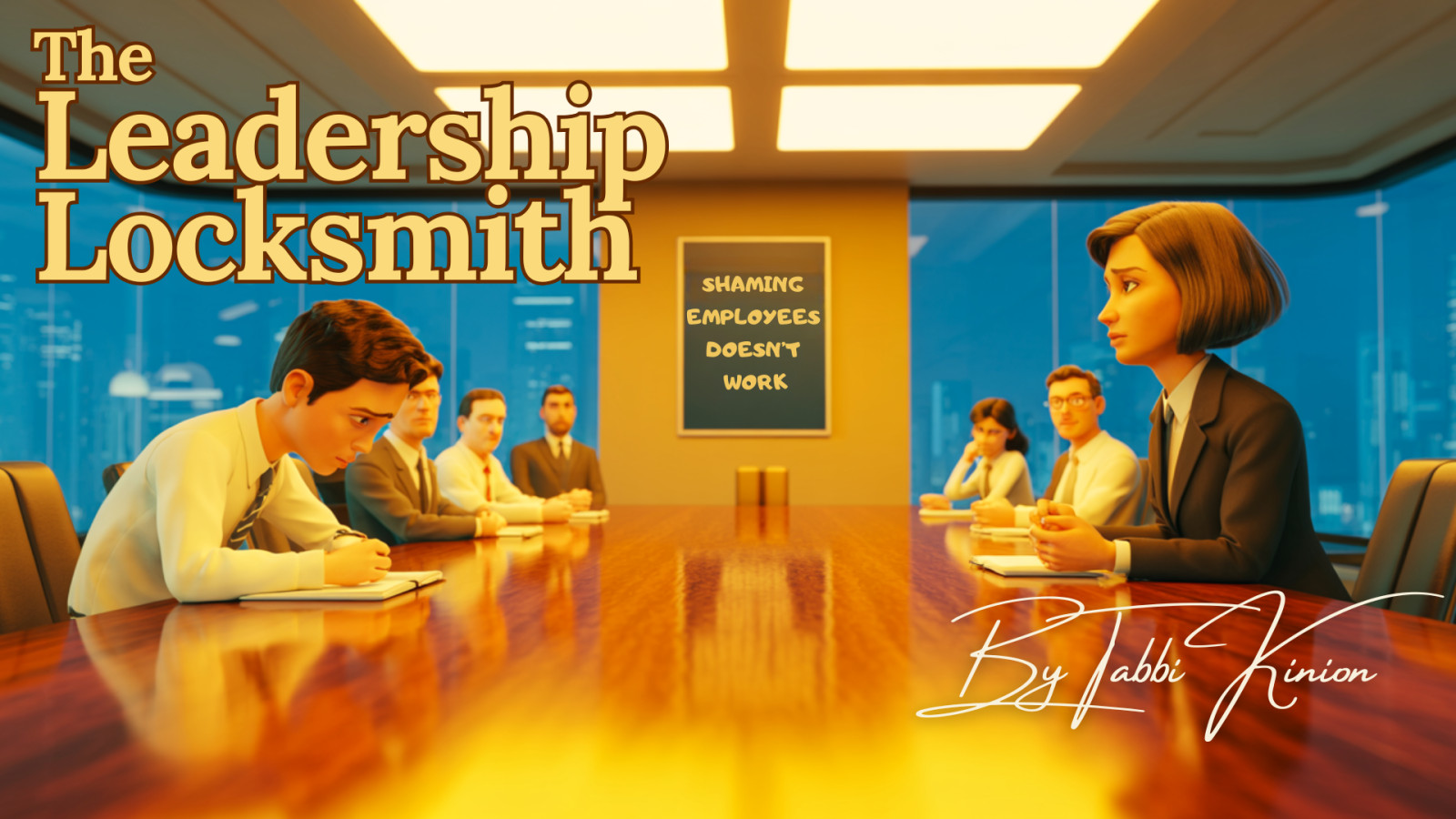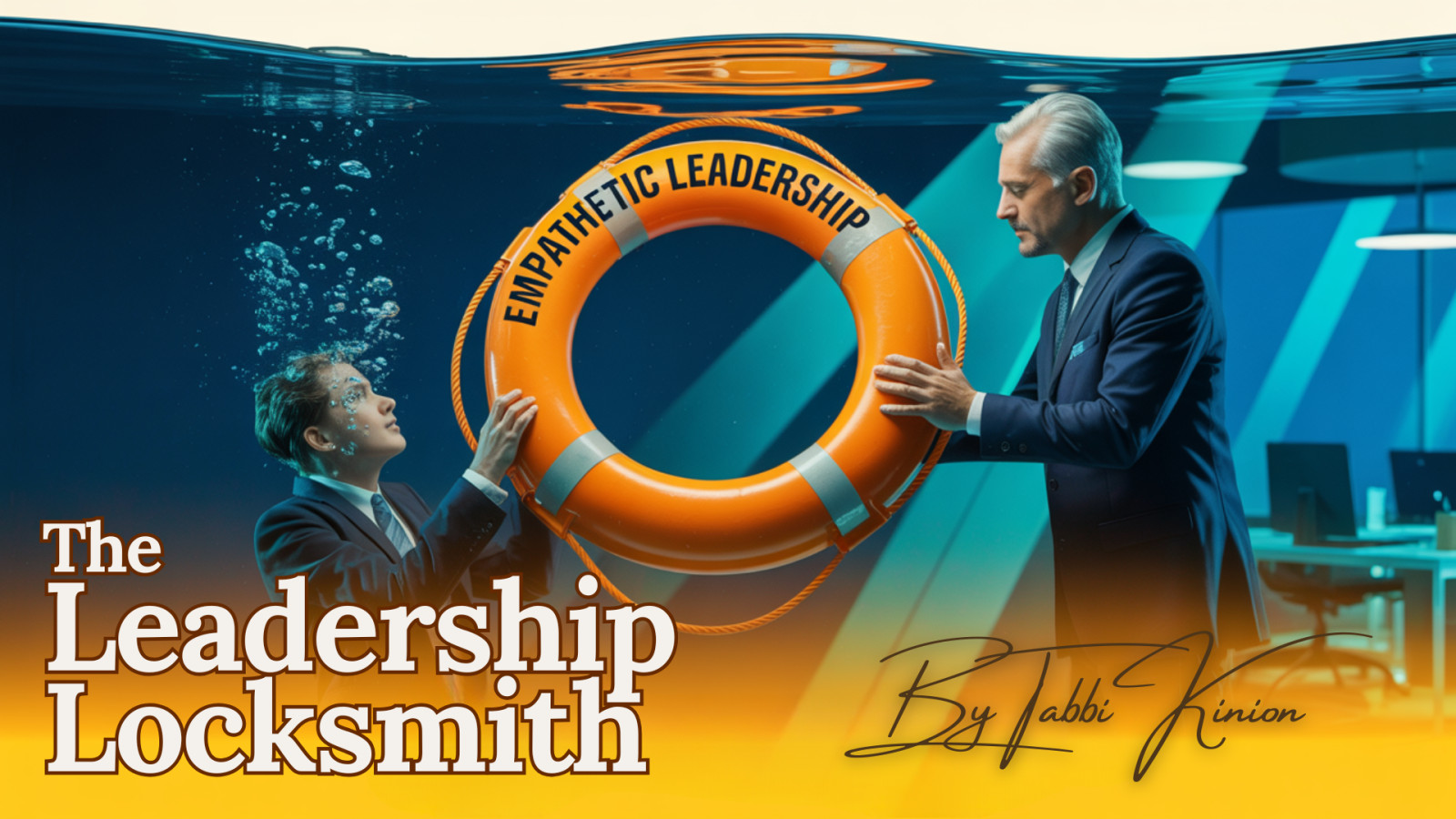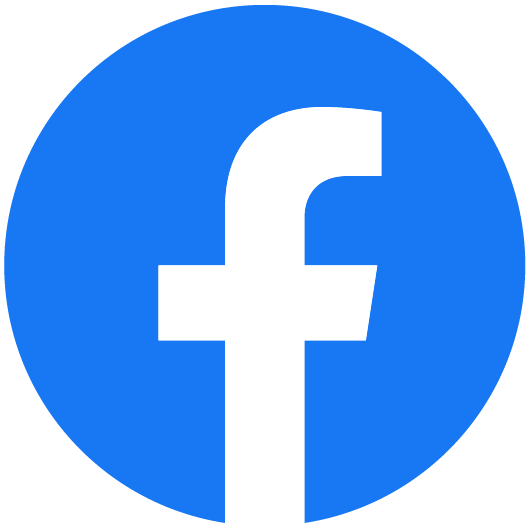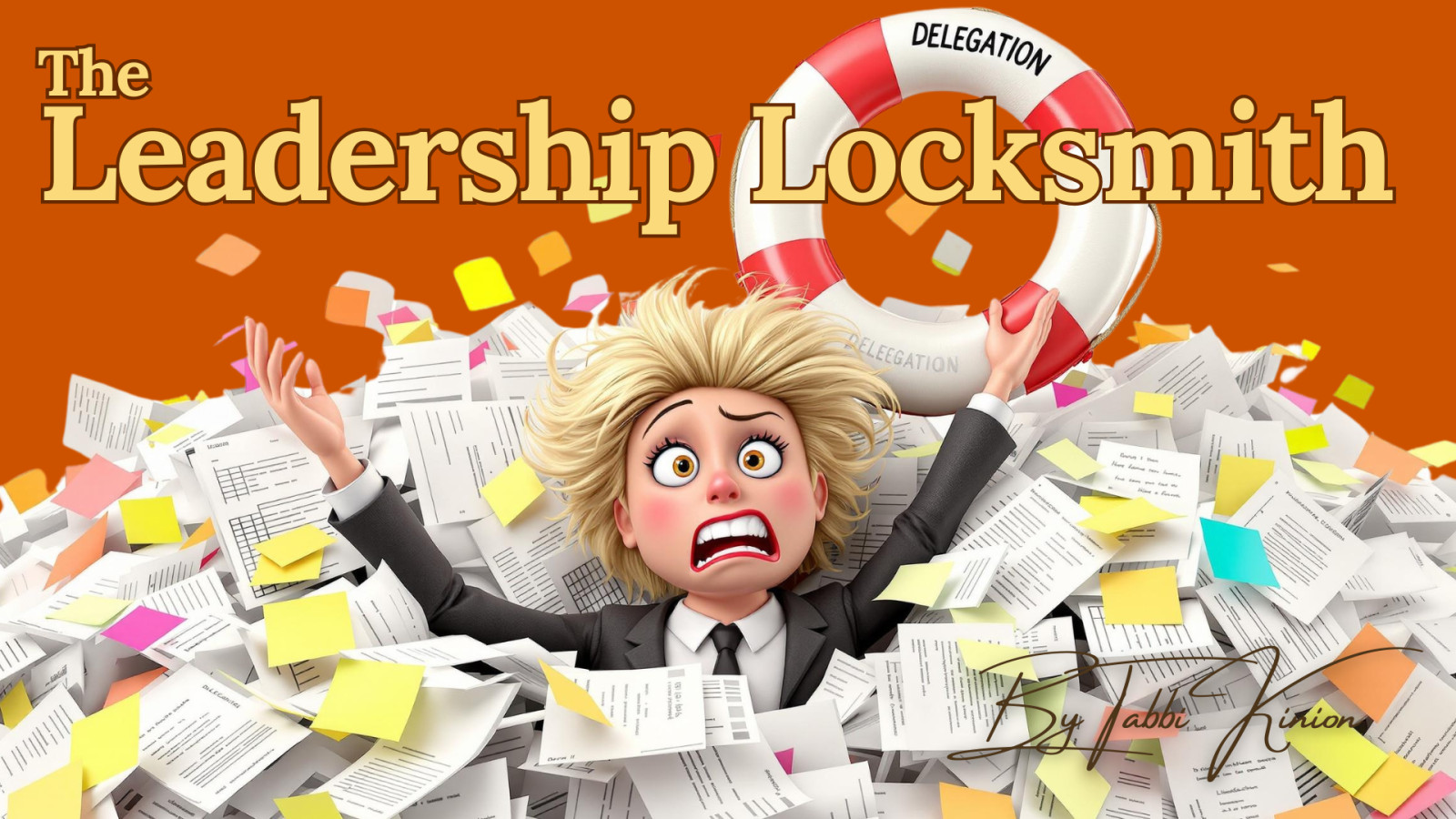
Last Thursday, I watched a group of talented leaders squirm uncomfortably when I asked a simple question: "What's stopping you from delegating more?"
The group was silent before one brave soul confessed, "I'm too busy to delegate."
Another added, "My team is already drowning. How can I possibly ask them to do more?"
These weren't ineffective leaders - these were caring, conscientious people trapped in a mindset that hurts them, their teams, and their organizations.
Why Delegation Matters
Delegation isn't just a nice-to-have leadership skill. It's the difference between merely surviving as a leader and truly thriving.
A leader who refuses to learn how to delegate is like the restaurant owner who insists on cooking every meal, washing every dish, greeting every customer, and managing the books. Even if you're exceptional at each individual task, your restaurant will never grow beyond what you can personally accomplish in a day.
Effective delegation multiplies your impact exponentially. It transforms you from a doer of tasks to a developer of people. It's how you scale your abilities beyond what one person could possibly achieve alone.
The benefits extend to everyone - managers gain time for strategic thinking, team members develop new skills, and organizations build bench strength. Yet delegation remains one of the most underutilized and underdeveloped management skills.
More importantly, leveling up your delegation skills is how you reclaim the balance that makes your leadership sustainable for the long haul. No one can run at full speed forever. The leaders who last aren't necessarily the most talented; they're the ones who know how to share the load.
Code word of the week: DELEGATE
Being great at delegation is essential for your leadership success.
If you're going to thrive as a leader with significant work responsibilities while maintaining balance with your home life, your delegation practice needs serious attention.
This isn't just about distributing work. It's about strategically entrusting tasks and empowering others with decision-making authority.
A 2007 study by the Institute for Corporate Productivity (i4cp) found that nearly half of the companies surveyed were concerned about their employees' delegation skills. Yet, only 28% offered any training on the topic. The study is old, but the data is still relevant today. This gap explains why so many leaders struggle with a skill that seems simple in theory but proves incredibly challenging in practice.
The Real Barriers to Delegation
During our Trust, Delegate, Thrive workshop last week, we uncovered the true obstacles that keep even the most well-intentioned leaders from delegating effectively:
- The "Too Busy" Paradox: "I'm too busy to take time to delegate." This is like saying you're too thirsty to get water. The moment you feel too overwhelmed to delegate is precisely when you most need to stop and hand things off.
- The Guilt Factor: "I don't want to burden my already busy team."
- The Speed Illusion: "It's faster to just do it myself than explain it to someone else."
- The Perfect Standard: "No one will do it exactly the way I would."
- The Identity Crisis: "If I'm not doing the work, what value am I adding as a leader?"
Let's be honest: delegation feels profoundly unnatural to most of us. And especially for those of us who are overachievers and were incredibly productive individual contributors before landing our leadership promotions. Delegation requires that you slow down when you're already racing, invest time upfront for a later payoff, and accept results that will be less perfect than what you'd produce on your own. Everything about delegation runs counter to the high-achieving, perfectionist tendencies that likely got you promoted in the first place.
This is precisely why leadership training, coaching, and community support are non-negotiable for today's leaders. The skills that made you successful as an individual contributor are often the exact opposite of what you need as a leader. Without expert guidance, honest feedback, and the perspective of other leaders facing similar challenges, most of us default to doing rather than delegating, creating a ceiling on our leadership excellence. True leadership superstars recognize that going it alone limits their potential to transform teams, drive results, and create lasting impact. The highest achievers understand that support isn't a crutch; it's the rocket fuel that propels them beyond what they could accomplish solo.
Breaking Through Your Delegation Blocks
When I challenged these leaders to flip their perspective, everything changed. Here's just a glimpse of the delegation breakthrough strategies that transformed their approach (and that I share in-depth with my leadership clients):
Recognize the red flag - When you catch yourself thinking "I'm too busy to delegate," treat it as an alarm bell. This thinking signals that delegation is exactly what you need most urgently.
Reframe delegation as an opportunity, not a burden - Your team members want chances to grow, develop new skills, and demonstrate their capabilities. When you withhold challenging work, you're not protecting them. You're limiting them.
There's so much more to effective delegation than most leaders realize, from the psychology behind your resistance to the specific language patterns that inspire rather than overwhelm your team. In our Leadership Locksmith System, we dive deep into the advanced delegation frameworks that transform overwhelmed managers into confident, balanced leaders.
The breakthrough moment in our session came when a participant realized: "I've been trying to be a shield between my team and work, when I should have been a guide helping them navigate through it."
That shift - from shield to guide - captures the essence of delegation done right. It's just one of dozens of perspective shifts that unlock your leadership potential when you have the right support system and proven methodologies at your fingertips.
Getting the Support You Need
Developing strong delegation skills rarely happens in isolation. Like any complex leadership skill, it benefits tremendously from structured guidance, feedback, and accountability.
This is why I'm so passionate about providing integrated coaching and training that addresses both the tactical aspects of delegation (what to delegate, how to communicate expectations) and the psychological barriers that often prove more challenging to overcome.
The next time delegation guilt creeps in, remember: your job isn't to protect your team from work, it's to help them thrive through meaningful work. And that starts with trusting them enough to hand over the keys to tasks that matter.
Ready to transform your approach to delegation? The Leadership Locksmith System offers a framework for unlocking your team's potential through effective delegation and priority management. In the next few weeks, I will unveil some exciting bonuses for those who join this integrated coaching and training program designed specifically for leaders who want to build confidence, create balance, and drive results without burning out.
Now, look at that long to-do list and delegate something! There's nothing like the present to get started!

I was leading a leadership workshop last week when it happened again. As we dove into the messy realities of coaching difficult employees, a participant's shoulders visibly relaxed as she admitted, "I thought I was the only one who struggled with this. It makes me feel better to know I'm not alone."
The rest of the room nodded in unison, that silent acknowledgment of shared experience washing over the group like a wave of relief.
Twenty-plus years into my leadership journey, and I'm still struck by how often I hear some version of this confession. It's the leadership equivalent of thinking you're the only one with the weird body thing until you Google it and discover millions of others have it too. (Spoiler alert: that thing where your eye twitches when you're stressed? Totally normal. Same with feeling like a leadership imposter.)
So here's my question for you today: If leadership is inherently challenging for everyone, why are you still trying to figure it out alone?
The Leadership Lone Ranger Syndrome
Most of us get promoted because we're exceptional individual contributors. One day, you're crushing your personal targets, and the next, you're responsible for an entire team's success, with little to no formal preparation for this seismic shift.
This leadership journey is like being thrown behind the wheel of a car after years of just being a passenger. Sure, you've watched driving happen thousands of times. You know what it looks like when someone changes lanes or parallel parks. But that first moment when you're actually in the driver's seat? Total different story.
So what do we do? We white-knuckle the steering wheel and assume leadership will come naturally through experience alone. After all, we've been watching people drive—err, lead—for years. Surely we've picked up what we need through osmosis, right? 🤷♀
Here's the kicker: those leaders you've been watching at the wheel? Many of them are just as lost as you feel, overcorrecting and occasionally driving on the rumble strips of leadership. They're just better at looking confident while being confused. It's not your fault—the system is literally designed this way.
There's a reason we don't just hand teenagers keys and say, "You’ve been in cars your whole life, you'll figure it out!" We give them driver's ed, supervised practice, and graduated licensing. Yet somehow, we expect new leaders to navigate the complex highways of leadership with no GPS, no driving instructor, and everyone else on the road equally clueless.
The Hidden Costs of DIY Leadership
The "figure-it-out-myself" approach to leadership development extracts a steep price:
- Your team becomes unwitting passengers in your leadership test drive (no consent forms provided)
- Projects take longer, and conflicts simmer beneath the surface like that questionable leftover chili in the break room fridge
- That nagging imposter syndrome follows you home each night, whispering that everyone else has this figured out (they don't, trust me, I see their DMs)
- Your true leadership potential remains locked away, inaccessible without the right keys
I see this every day in my coaching practice. Leaders who've spent years - sometimes decades - trying to MacGyver their way through leadership challenges that others have already solved.
As one client recently told me, "I wasted seven years making the same mistakes over and over before I realized I needed help. That's seven years I can't get back."
Leadership Is More Complex Than Ever Before
As you are well aware, the leadership landscape has transformed dramatically in recent years.
Today's leaders face challenges that simply didn't exist a decade ago:
- Teams scattered across time zones, cultures, and work arrangements (someone is always in pajama bottoms - and that someone is often me)
- Technology is constantly shifting how we communicate and collaborate (remember when "Zoom" was just what cameras did?)
- Flatter organizations require more influence and less authority
- Heightened expectations for leaders to address employee wellbeing and purpose, not just performance
It's like driving evolved from simple country roads to a complex network of superhighways, roundabouts, and rush-hour traffic. At the same time, your vehicle gained hundreds of new features, buttons, and dashboard warnings. You wouldn't expect to navigate that complexity without updating your skills, would you?
And let's be honest, those week-long leadership training retreats where you take notes furiously? They're about as effective as crash diets. You return to your desk with a binder full of good intentions that quickly get buried under the avalanche of emails and schedule of meetings that accumulated while you were gone. Real growth happens in the trenches, not in the classroom.
You Need a Guide, Not Just Another Map
When I was building my first team, I collected leadership books like they were going out of style. I highlighted passages, took copious notes, and attended every seminar and workshop I could find. My bookshelf was impressive. My leadership skills, well, not as much.
But when the rubber met the road - when I was facing a chronically underperforming team member or navigating a complex change initiative - all those books gathered dust on my shelf. What I really needed wasn't another map but a guide who had navigated this terrain before and could talk me through the parts where the map just says "here be dragons."
Someone who could help me apply those theoretical concepts to my specific situation. Someone who could spot my blind spots (like my oh-so-common tendency to avoid conflict until it exploded like a workplace volcano). Someone who could help me unlock my authentic leadership style rather than copy someone else’s (turns out I'm not Brené Brown, despite my tendency to start sentences with "Research shows...").
The Leadership Code Word of the Week: SUPPORT 🔑
Great leaders understand that seeking support isn't a sign of weakness but a strategic advantage, like having air conditioning in August. The most successful leaders I've worked with all share this quality: they actively build support systems that help them lead more effectively.
Your leadership support system might include:
- A formal leadership coach (like me!) who provides personalized guidance and the occasional reality check
- Peer networking groups where you can share challenges in a safe space (and realize you're not the only one who accidentally muted yourself for five minutes on that important call)
- A mentor who's navigated similar terrain before you (battle scars included)
- Structured leadership development programs that provide frameworks and skills (no binders required)
- Regular feedback loops with your team and leaders (scary but worth it)
Your Leadership Challenge:
This week, I challenge you to take one concrete step toward building your leadership support system:
- Schedule coffee with a leader you admire and ask about their leadership journey (best with actual coffee, not just as an email subject line)
- Join an industry or role-specific leadership community (online or in-person)
- Identify one leadership challenge you're facing and ask a trusted colleague for their perspective (even if you think you already know the answer)
- Research leadership development programs that align with your current challenges (and don't require selling a kidney to afford)
- Book a leadership clarity call to discuss your specific leadership struggles (I might know someone who can help - message me 😉)
Remember, every leader you admire has their support system. They're not doing it alone, so why are you trying to? Leslie Knope had Ron Swanson's straight talk (and occasionally Ann Perkins' reality checks). Ted Lasso relied on Coach Beard, and Jack Donaghy had Liz Lemon keeping him connected to reality.
Your work matters too much to struggle through leadership challenges that others have already solved. Your team deserves a leader who's constantly growing and developing. And you deserve the confidence and satisfaction of leading with clarity and purpose.
The key to unlocking your leadership potential isn't working harder; it’s working smarter by leveraging the wisdom and support of others who've walked this path before.

That Awkward Moment When Your Brain Goes on Vacation…
Have you ever stood in the cereal aisle, staring at the wall of 57 varieties, completely unable to choose one? You know the feeling - your brain is simultaneously overloaded with options, yet eerily empty when it comes to making the final decision?
Now picture this: You're sitting at the head of the conference table at your office. Expectant faces are turned toward you, awaiting your decision that will guide their work for the coming months. And suddenly, your mind goes completely blank. The decision-making part of your brain seems to have taken an unscheduled vacation without you, leaving you stranded in a moment of pure, unadulterated panic. You fumble something out to the team, putting off that decision again.
If you're nodding along, congratulations! You've experienced the joy (aka panic) of decision paralysis—it's like the mental blue screen of death, but without a restart button. Whether you've been the deer in the headlights yourself or watched in silent sympathy as a colleague froze when all eyes turned their way, this leadership moment is as universal as it is uncomfortable.
It's Not Just You
After more than two decades in leadership positions, I can tell you that this mental freeze isn't a sign of incompetence—it's what happens when your brain decides to throw a tantrum under the pressure of your long list of responsibilities. The higher the stakes, the more likely your decision-making abilities are to pack their bags and ghost you completely.
According to Harvard Business Review research, decision paralysis stems from several common sources:
- Fear of making the wrong choice (and having to awkwardly explain it later)
- The relentless pursuit of the "perfect" solution (spoiler alert: like unicorns, it doesn't exist)
- Information overload that leaves you drowning in data and gasping for clarity
- Lack of clear decision criteria (when "eeny, meeny, miny, moe" starts looking like a viable strategy)
Anxiety: Your Brain's Unhelpful Backseat Driver
It’s terrible and fascinating how anxiety and decision paralysis dance together in a dysfunctional tango. At its core, anxiety is your brain in overdrive—thinking too much, too fast, and too catastrophically. When facing important choices, this mental acceleration kicks into high gear, making us desperate for help.
That’s productive, right? Wrong.
That same anxious overthinking impairs our ability to evaluate our options clearly. When we're anxious about a decision, research shows we become both more likely to seek advice AND less able to distinguish between the good and bad advice. Our brains are literally racing so quickly that they can't properly process the information being received. It's like trying to read a book while speeding down the highway at 90 mph—technically, you're looking at the words, but comprehension? Not happening. And it’s all a recipe for disastrous outcomes.
This anxiety-decision paralysis loop creates a perfect storm: You can't decide because your thinking is in overdrive, and your thinking stays in overdrive because you can't decide. It's the leadership equivalent of that frustrating Netflix buffering icon. Everyone is ready for the show to start, but now they're all awkwardly waiting while you are secretly panicking about your internet connection.
This brings us to this week's leadership code word: Detour.
Take a Detour When Your Brain Hits a Roadblock
When decision paralysis strikes, sometimes the best move is a strategic detour. Like a GPS recalculating after a wrong turn, your brain needs to find an alternative route to clarity.
Think of anxiety as your brain's rumble strips. Just like those grooves on the highway that vibrate when your car drifts out of its lane, anxiety is feedback telling you your thinking has gone into overdrive. Many of us believe there's something fundamentally wrong when anxiety hits—that the entire car needs a complete overhaul. But really, those rumble strips are just doing their job!
Anxiety is simply your "thinking too fast" check engine light. Nothing more, nothing less. It's not telling you to abandon the vehicle—just to slow down your thinking and get back in your lane. When you notice your mind racing through worst-case scenarios faster than most toddlers run from vegetables, that's your cue to pump the mental brakes.
Breaking Free From That Decision Quicksand
So, how do we deal with decision paralysis in leadership moments without faking a medical emergency to escape the room?
Here are some proven techniques - I bet some of these will help you out!
- Recognize the freeze: "Ah, there you are, decision paralysis, my old frenemy!" Naming it takes away some of its power.
- Slow down your thinking: Take deep breaths. Your best decisions rarely come when your thoughts are running around like caffeinated squirrels.
- Schedule big decisions for morning hours: Make important decisions when your brain is fresh, not when it's been through the mental equivalent of a marathon. Research shows our decision-making abilities decline throughout the day as we experience decision fatigue.
- Sleep on it: Giving your brain overnight processing time works wonders! When you actually slow down and sleep, your subconscious sorts through options, makes connections, and often delivers clarity by morning. It's not procrastination—it's strategic patience!
- Implement decision deadlines: "I will decide by 2 PM tomorrow or I will donate $50 to my least favorite political candidate." Nothing motivates like a little self-imposed blackmail!
- Filter your choices: Quickly eliminate options that don't align with your goals. Or as Marie Kondo might say, keep only the options that spark joy (or at least minimal dread).
- Remember that indecision is a decision: As research shows, more is lost through indecision than wrong decisions. A mediocre plan executed now usually beats a brilliant plan executed never.
When DIY Decision-Making Fails: Call in the Pros
Sometimes, chronic decision paralysis needs more than self-help strategies. If you find yourself perpetually stuck in the mud of indecision, it might be time to bring in a leadership coach who can be both your sounding board and your kick-in-the-pants.
A good leadership coach doesn't make decisions for you—they help you identify the hidden barriers keeping you stuck. They're like having a personal trainer for your decision-making muscles, someone who won't let you skip leg day (or tough decisions day).
In my work with overwhelmed leaders, I've seen how the right coaching relationship can transform chronic indecision into confident action. Sometimes, you just need someone in your corner who can look you in the eye and say, "You've got this—and if you don't decide by Friday, I'm going to keep asking about it until you do."
Your Leadership Challenge: From Paralysis to Progress
For your leadership challenge this week, identify one decision you've been avoiding longer than milk should stay in your refrigerator. Apply the steps above, set a deadline, and commit to making that decision. Then notice how it feels to move forward, even if the path ahead has more potholes than a Michigan highway in springtime.
Remember, the most effective leaders aren't those who make perfect decisions 100% of the time. They're the ones who make timely, confident decisions, learn from the results, and—when necessary—know how to gracefully say, "Well, that didn't work as planned, but watch how elegantly I pivot!"
So the next time you find yourself frozen in indecision—whether in the cereal aisle or the boardroom—remember to take a DETOUR. Your leadership rumble strips are just doing their job, and sometimes the scenic route leads to better destinations anyway.
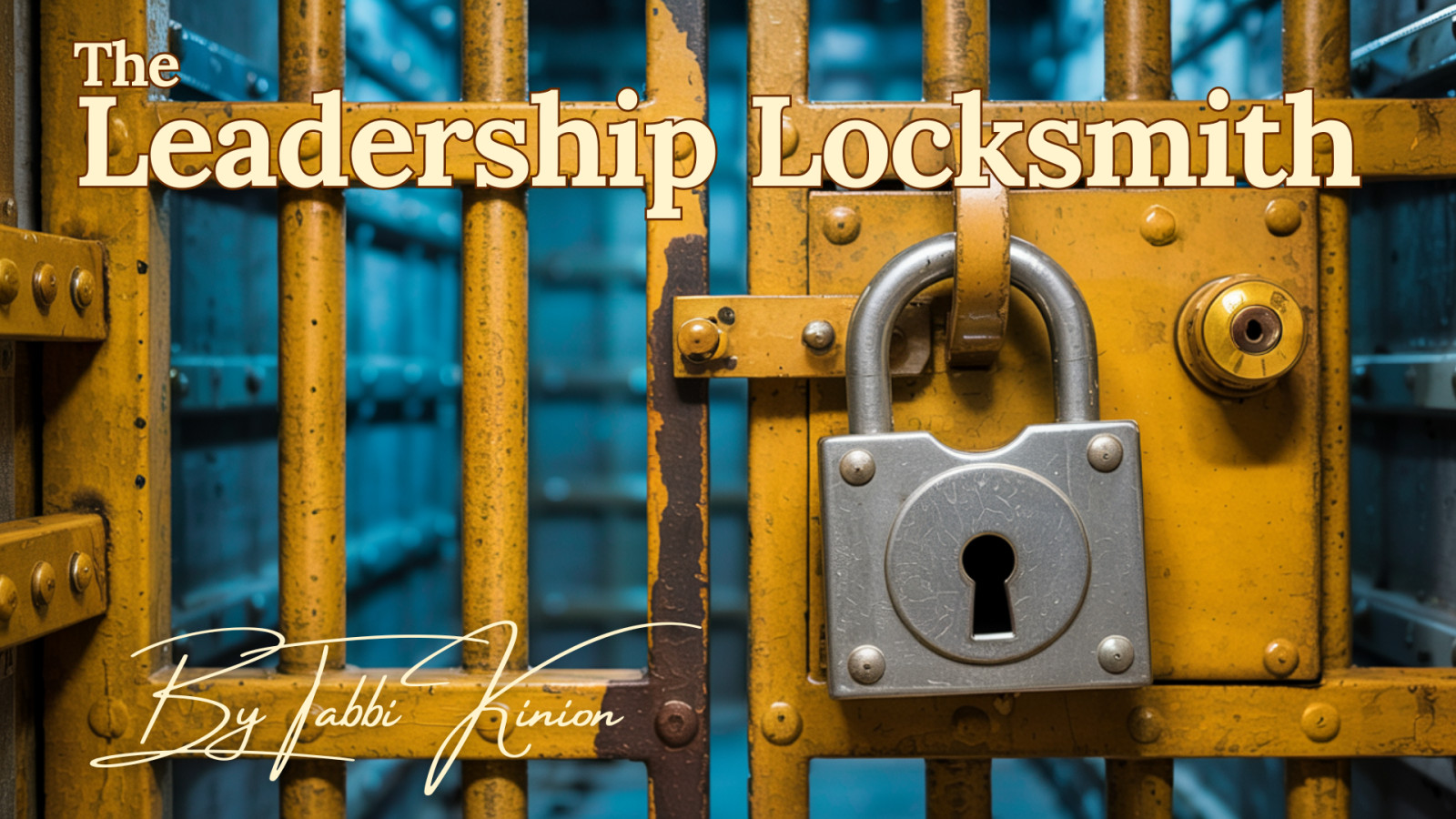
Have you ever sat in your desk chair, looked over at the nameplate on your door, and thought, "Any minute now, they're going to realize they've made a terrible mistake hiring me"?
If so, welcome to the not-so-exclusive club of successful leaders battling imposter syndrome. Trust me, I’ve spent more nights than I care to admit staring at the ceiling, wondering when everyone would figure out I was making it up as I went along. That nagging voice with all the lies—"You don't belong here"—doesn't discriminate. It whispers to new managers and seasoned executives alike, including yours truly and pretty much every accomplished leader I've worked with over the past two decades.
I still remember taking over as Education Division Chief in 2018 as if it were yesterday. I was suddenly responsible for a team spread across the entire state of Arkansas—a place I barely knew. Every morning, I'd walk into the office juggling impossible tasks: learning an unfamiliar culture, finding my way around the building, memorizing dozens of names, and somehow projecting confidence about a job I was still figuring out. Talk about feeling like the imposter in the corner office!
Each evening, I'd drive home with The Fray's Over My Head (Cable Car) blasting through my car speakers—the song isn't about leadership, but the lyrics Everyone knows I'm in over my head, over my head... became my personal anthem. 🎵
What kept me going? A simple daily practice. During that same drive home, I'd force myself to mentally list everything I'd done that day to help my team succeed—even the smallest wins. "I connected Kelly with a resource she needed." "I cleared that administrative roadblock for Grant." "I gave useful feedback that helped improve that presentation."
This little ritual didn't magically cure my imposter feelings, but it did something powerful: it shifted my focus from what I didn't know to the actual value I was bringing, even while feeling completely out of my depth.
The Real Cost of Feeling Like a Fraud
According to Harvard Business Review, imposter syndrome can sabotage your leadership in several critical ways:
- It erodes your self-confidence. Despite your accomplishments, you struggle to internalize success, creating a cycle of self-doubt and hesitation.
- It cranks up your anxiety. The constant fear of being "found out" creates unnecessary pressure and fast-tracks you to burnout.
- It kills your ability to be innovative. When you're terrified of making mistakes, you stick to safe, conventional approaches rather than taking calculated risks.
- It undermines your presence. Your feelings of uncertainty leak into how you interact with others, making you appear less decisive and authentic.
- It clouds or slows your decision-making. When you're second-guessing yourself constantly, making clear, confident, timely decisions becomes nearly impossible.
This Week's Leadership Code Word: AUTHENTIC
Being an authentic leader doesn't mean you have all the answers—it means being honest about what you know and don't know, and confident in your ability to figure things out. When you drop the exhausting fraud act and lead with transparency, you not only feel better, you actually become more effective and trustworthy in the eyes of your team.
Unlock Your Authenticity: Start These Strategies Today
Recent insights from the Forbes Business Council confirm what we've all experienced—imposter syndrome is universal in leadership, but conquerable.
The secret that transformed my own leadership journey? Embracing authenticity. When I stopped worrying about how to be the "perfect leader" and started showing up as my real self—someone with both strengths and growth areas—something remarkable happened. I slept better. And, my team trusted me more, not less. They felt permission to be authentic, too, creating a culture where real innovation could happen.
Authenticity doesn't mean oversharing or abandoning professionalism. It means acknowledging when you don't have all the answers, being transparent about challenges, and demonstrating genuine curiosity about solutions. It's sharing credit generously while taking full responsibility. It's leading from a place of truth rather than pretense.
Here's your path to more authentic and less imposter-y leadership starting today:
📝 Document your wins daily. Create a "Leadership Wins" folder where you record accomplishments and positive feedback. As leadership expert Egor Kirin notes, "When you define the benefits you bring, there will be no room left for doubts." List three leadership actions you took this week that made a positive difference.
👥 Activate your support squad. Identify two people this week who can become your "reality checkers"—peers or mentors who understand leadership challenges. Schedule a coffee with one of them and be brave enough to share your imposter feelings. I think you will be relieved to find that nearly everyone you talk to will resonate with your experience.
🔑 Join forces with other leaders. Don't battle imposter syndrome alone! Leaders who invest in coaching and training programs with built-in communities overcome self-doubt faster. When you hear peers confess the same fears you've been hiding, that "I don't belong" feeling starts to dissolve, replaced by practical strategies that actually work.
The next time imposter syndrome creeps in (and it will), practice this 3-step process:
- Recognize: "I notice that I'm having deceptive thoughts that are causing me to feel like I don't belong in this role."
- Challenge: "Despite feeling uncertain right now, I know this isn't true because I've successfully led my team through [specific accomplishment]."
- Reframe: "This discomfort is normal, and it means I'm becoming a stronger leader."
And if all else fails, take comfort in leadership researcher and neuroscience expert Dr. David Lenihan's advice: "Keep going. Eventually, that persistent feeling of guilt, uncertainty, and insecurity that follows you around will gradually fade away." Sometimes, leadership is simply about staying in the game long enough for your confidence to catch up with your capabilities.
The most dangerous imposters aren't the leaders who occasionally doubt themselves—they're the ones who never do. A healthy dose of humility combined with earned confidence is the sweet spot of authentic leadership.
P.S. If you know a colleague who might be silently battling imposter syndrome, forward this article their way. Sometimes knowing we're not alone in these feelings is the first key to overcoming them. 🔑
________________
While inner work is essential, sometimes your visual brand needs to catch up to the leader you're becoming. As both a leadership coach and visual brand specialist, I've seen firsthand how polished professional imagery creates an immediate confidence boost. My custom AI portrait packages create instant credibility across all your platforms—no expensive photoshoots required! Sometimes, looking the part helps quiet that inner critic. Ready to let your visuals match your leadership potential? Check out this page.

Have you ever had a moment when an employee breaks down in tears during a meeting, and suddenly you're the proverbial deer caught in their emotional headlights?
I'll never forget when one of my toughest team members—a retired SWAT officer built like a brick wall—collapsed into tears in my office after losing his beloved dog. For a split second, I panicked. Should I look away? Offer a tissue? Pretend it wasn't happening? And then I remembered that all I needed to do was be there. And really listen while he shared his heartache. Because in tragic moments like these, we all need someone to listen and care that we are hurting inside, right?
Times like these are a great reminder that being human isn't a leadership weakness—it's our greatest superpower.
The Truth About Bad Days
Let's get one thing straight: humans have bad days. All of us. It’s part of the deal—there is no “only good days” option. Even those Instagram-perfect leaders with their polished exterior, color-coded calendars, and spotless offices wake up in a bad mood or have a craptastic day on occasion.
As leaders, we can't prevent emotions—good or bad—from happening in the workplace. What we can control is how we respond to them and the environment we create around emotional expression. The real skill isn't shutting down emotions or letting them run wild—it's finding that sweet spot in between.
Great leaders understand that emotions are data, not distractions. When emotions arise, you get to put your Sherlock hat on—they're telling you something.
Your Mood Sets the Tone
One of the heavy burdens of leadership is that your emotional state ripples through your entire team.
According to the Harvard Business Review, a leader's mood:
- Sets the emotional tone for everyone else
- Influences team dynamics and productivity
- Impacts motivation levels across the board
- Shapes organizational culture over time
I learned this lesson the hard way, one particularly rough morning after a sleepless night. My team was laughing together when I walked in, and instead of joining their moment of connection, I grumbled about the noise and retreated to my office. The energy instantly deflated like a punctured balloon. My bad mood wasn't about them, but they spent the day walking on eggshells, wondering what they'd done wrong.
It's unfair that leaders live under this emotional magnifying glass, where our normal human reactions get amplified across our team like ripples in a still pond. But it's the leadership contract we signed in invisible ink when we accepted the role. It's hard work—sometimes exhausting—to maintain this emotional awareness. That morning, when I inadvertently shut down the fun, was a powerful reminder—I was probably sending these invisible signals all the time without realizing it. Leaders, let's be honest: your mood walks into the room about ten minutes before you do. How is your emotional weather system affecting your team today?
When Your Team Gets Emotional
Now, for the trickier part, when your team members are the ones experiencing intense emotions and standing in front of you, the worst thing you can do is shut them down with statements like "There's no crying in business" or "Leave your feelings at the door."
When they are sharing struggles in their personal life:
- Acknowledge their challenge without minimizing it
- Be flexible where appropriate
- Check in with genuine concern, not micromanagement
- You do not need to have answers or know what to say - listen and ask what they need
For work-related emotions:
- Use coaching questions (I love the ones in The Coaching Habit by 📚Michael Bungay Stanier ) to help them process productively
- Maintain appropriate boundaries and expectations
- Hold them accountable while showing empathy
- Keep your feedback constructive, even when it's tough
About Those Tears Though...
Let's talk specifically about tears, since they tend to create the most discomfort for leaders.
When an employee tears up in your office, remember this isn't a crisis to solve—it's simply a moment of trust. They feel safe enough to be vulnerable with you. That's an honor, not a problem.
Your job isn't to stop the tears or feel awkward. The person in front of you is not broken; they are showing human emotion and feel safe enough to do so in your presence. Simply hand over a tissue, give them space, and be present. Once the moment passes, then you can have the conversation that needs to happen. After all, you and I both know that in moments of overwhelming emotion, people don't make great logical decisions.
Tears don't mean someone is broken, manipulative, or unprofessional. They signal courage, authenticity, and a depth of caring that our workplaces desperately need. When you respond with calm compassion rather than discomfort, you're not just handling the moment—you're modeling what truly powerful leadership looks like. The best leaders don't fear emotion; they create space for it, knowing that's where genuine connection and breakthrough performance begin.
(Side note: In rare cases, tears can be manipulative - like the employee who burst into theatrical sobs when asked to remove an inappropriate social media post, even saying "I bet you want me to stop crying..." My response? "It sounds like you need a good cry." I acknowledged her feelings without backing down, and miraculously, the waterworks dried up instantly. Trust your gut when something feels off, but don't let your discomfort around genuine emotion keep you from being a compassionate leader.)
Leading With Emotional Intelligence
Emotional intelligence is your ability to recognize, understand, and manage your own emotions while skillfully navigating the emotions of others, like having both an internal compass and an external radar that guides your leadership decisions and relationships.
As a leader, you have a unique opportunity to model healthy emotional intelligence:
- Be authentic about your own emotions
- Demonstrate effective emotional regulation
- Show how to name and acknowledge your feelings
- Illustrate how emotions can inform decisions without dictating them
When your team sees you navigating emotions skillfully—acknowledging feelings without letting them derail you—they learn to do the same.
This Week's Leadership Code Word: Presence
Presence means that you are fully engaged in the moment, including being able to recognize emotions without being swept away by them.
Your leadership challenge:
- Notice how your mood impacts your team
- Create a psychologically safe environment where your team can be authentic
- Establish clear expectations around appropriate emotional expression
- Model healthy emotional intelligence in your leadership
Remember, tears don't break teams.
Emotional suppression and unchecked emotional hijacking do.
✨ Ready to elevate your professional image to match your leadership growth? Check out our NEW AI Leadership Image Services! We'll help you create polished, professional visuals for your LinkedIn, presentations, and social platforms that reflect the confident leader you're becoming.
This article is based on a lesson from the Leadership Locksmith System, designed to help leaders unlock their confidence, build exceptional teams, and find balance in leadership. For more information on this customized-to-you coaching and training program, message me!

We've all been there.
That awkward moment when you realize you've been rehearsing that difficult-but-clearly-needed conversation in your head for weeks but, you just haven’t followed through yet. You know, the one with the team member who consistently misses deadlines but is otherwise brilliant. Or it’s the excited new employee who dominates every meeting trying to prove themselves, unaware they're silencing others. Or maybe it's the office superstar whose prickly demeanor is turning your team dynamic toxic.
I will never forget the day I finally gathered my courage to address an issue that had been festering in my team for months.
John (not his real name, of course) was a technically skilled, experienced, and hard-working employee – good at his job, dedicated, and incredibly knowledgeable about our systems. He was also completely unaware that his gruff communication style and impatient sighs were reducing our newest team member to tears.
Emily (also not her real name), just 20 and still in college, would literally hide in the bathroom after their interactions. She’d emerge with red eyes, insisting everything was "fine." But it wasn't fine – not for her, not for the team dynamic, and ultimately, not for John either. He had no idea what impact his behavior was having.
As I prepared for this conversation with John, I felt that familiar knot in my stomach. I wasn't ending his employment – but I was potentially ending his self-image as "just direct" and "efficient." This conversation required surgical precision: address the behavior clearly without crushing his spirit or making him defensive. I needed him to change his approach while still valuing his considerable contributions.
This moment – when your palms sweat, and you question if you're cut out for leadership – is precisely when your leadership identity is being forged.
The Hidden Cost of Avoidance
When we avoid or put off those difficult conversations, we're not being kind—we're being cowardly. And the cost is staggering.
The silence created by avoiding conversations creates a workplace where:
- Your top performers watch mediocrity, bad behavior, or even harassment go unchallenged, quietly losing respect for you.
- Your struggling employees miss crucial growth opportunities.
- The misunderstandings deepen past the point of return.
- Team trust erodes as everyone notices the elephant in the room, and you purposefully ignore it.
- Minor issues grow into career-limiting problems or, worse, disengagement and loss of essential team players.
As Kim Scott powerfully states in her book Radical Candor, when we avoid challenging directly (while caring personally), we fall into "ruinous empathy"—where our desire to be nice actually harms the person we're trying to protect. If you haven’t read her books or watched her videos - I highly recommend you look her up today!
Gallup data shows that employees who receive meaningful feedback are significantly more engaged, with 80% of employees who received meaningful feedback in the past week being fully engaged (McLain & Nelson, 2023). Even more striking, employees are 3.6 times more likely to be motivated to do outstanding work when their manager provides daily feedback versus annual feedback.
According to Gallup, meaningful feedback needs to be:
- Frequent - delivered at the moment, not saved for annual reviews
- Focused - specifically tailored to the individual's contributions and talents
- Future-oriented - emphasizing growth rather than dwelling on past mistakes
When we master giving feedback with this approach, we don't just solve problems—we transform our leadership impact.
The Brave Leader's Advantage
The leaders who master difficult conversations aren't just checking a leadership box—they're transforming their effectiveness and their team's performance.
When you become a leader who addresses issues promptly and skillfully:
- Trust multiplies exponentially—your team knows you'll be straight with them always.
- Minor issues stay small instead of growing into something major.
- Your culture becomes one of growth and excellence.
- Your own leadership confidence compounds with each successful conversation.
- Team members actually thank you for the clarity and guidance to help them improve.
That momentary discomfort of a difficult conversation is nothing compared to the lasting damage of silence. Your courage to speak up today could be the turning point in someone's career tomorrow.
This week's leadership code word is BACKBONE.
Not like a brittle and weak hunched-over backbone, but the strong, supportive, and flexible kind that helps you stand tall when it matters most. Having backbone in leadership means finding the courage to say what needs to be said, even when your hands might shake. The most meaningful conversations aren't going to be easy— but that's exactly what makes them worthwhile. When you develop this kind of backbone, you don't just solve problems—you build trust that transforms your entire team.
To help you strengthen your leadership backbone, I've created this Brave Talk Blueprint—a simple framework to turn those dreaded conversations into opportunities for growth and connection:

Have That Talk—This Week
My challenge to you is simple but powerful: Identify one conversation you've been avoiding and commit to having it within the next week.
Remember, the perfect moment won't arrive. Your perfectly rehearsed script will likely go out the window.
However, your genuine care for your employees, your clear focus on the issue (not the person), and your solution-oriented approach will carry you through. And in the end, the benefits will quickly overshadow any discomfort.
As Brené Brown puts it, "Clear is kind. Unclear is unkind." Avoiding the truth doesn't protect your team members—it robs them of the opportunity to grow.
The conversation you're dreading is the very one that could transform someone's career trajectory—and your leadership legacy.
What conversation have you been putting off that needs to happen this week?
This framework is from the Leadership Locksmith System, designed to help leaders unlock their confidence, build exceptional teams, and find balance in leadership. For more information on this customized-to-you coaching and training program, message me!
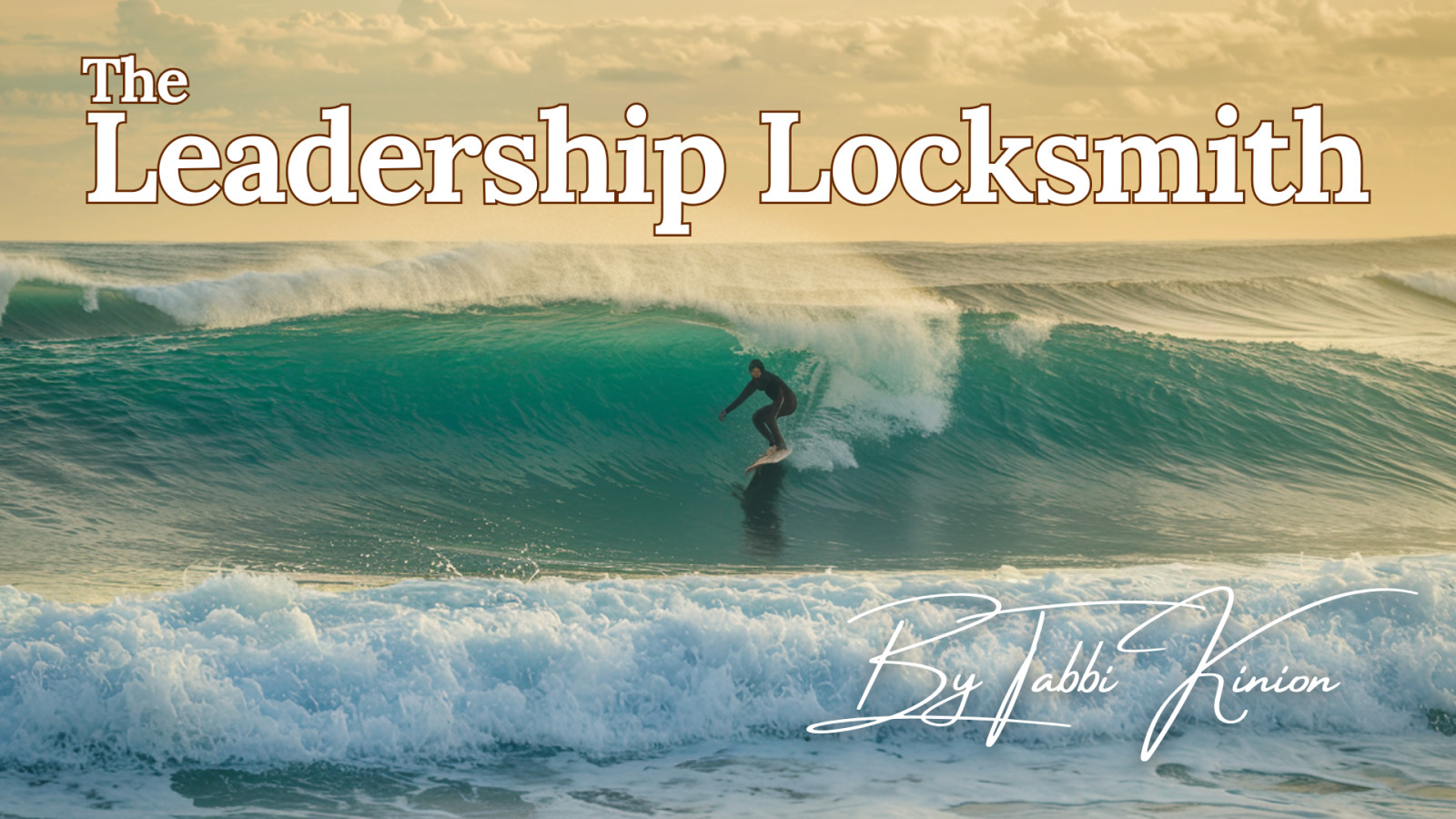
Did you catch the news this morning? Every headline screams CHANGE at us - political shifts, economic twists, technological revolutions, climate transformations. It's enough to make anyone's head spin!
And there you are, sitting in your leadership chair, knowing that every one of these massive global shifts will eventually ripple into your organization, team, and individual responsibilities. The question isn't if change will come knocking - it's when and how prepared you'll be when it does.
After 20+ years in management, I've seen leaders handle change in two distinct ways:
Reactive leaders wait for change to happen, then scramble to respond. They treat each change like a surprise thunderstorm without an umbrella.
Proactive leaders anticipate change, prepare their teams, and navigate the inevitable disruption with purpose. They've checked the forecast, packed umbrellas, and mapped out shelter locations before the first raindrop falls.
Which approach sounds less stressful to you? (Hint: it's not the first one!)
Why Change Leadership Matters Now More Than Ever
Let's talk about what you'll gain by mastering the art of leading through change:
- Higher Success Rates: While 70% of organizational changes fail, teams with skilled change leaders see dramatically better outcomes
- Maintained Productivity: A proactive approach minimizes that dreaded performance dip
- Talent Retention: People don't leave organizations because of change - they leave because of poorly managed change
- Adaptable Culture: Your team becomes naturally resilient rather than change-resistant
The Change Curve: It's a Journey, Not a Light Switch
One of the biggest mistakes I see leaders make is treating change like flipping a switch - announce it Friday, expect perfect adaptation Monday. But humans don't work that way!
Change follows a predictable pattern that looks something like this:

Notice something important: that dip in performance isn't failure - it's a natural part of the process. Understanding this curve gives us tremendous power as leaders.
When resistance and chaos emerge (and they always will), remember it's not irrational or negative. It's a human response rooted in legitimate concerns:
- Fear of the unknown: "What will this mean for me?"
- Loss of control: "I was good at the old way!"
- Concern about competence: "Will I succeed in the new system?"
- Workload anxiety: "This means more effort when I'm already stretched thin"
- Past scars: "The last change was a disaster."
Resistance isn't your enemy - it's valuable information telling you exactly what needs addressing. And it's never personal, just deeply human.
Your Own Emotions Have a Multiplier Effect
Here's an uncomfortable truth: your reaction to change has a ripple effect throughout your team. If you approach change with anxiety or frustration (even if you think you're hiding it well), that energy spreads like wildfire.
This doesn't mean faking positivity. It means doing your internal work first. Process your reactions with peers or mentors before addressing your team. Your people don't need you to be perfect - they need you to be steady, thoughtful, and genuinely committed to navigating change together.
This Week's Leadership Code Word: ANTICIPATE
Being a proactive change leader means developing your ability to anticipate - not just the change itself, but the human responses to it.
Three powerful mindset shifts can transform how you lead through change:
- Adopt a Learning Orientation: Approach change with curiosity rather than certainty
- Embrace Both/And Thinking: Acknowledge both the potential benefits AND the legitimate challenges
- Focus on Influence, Not Control: You can't control the change, but you can influence how you and your team respond
Your Leadership Challenge
Before your next team meeting, take 10 minutes to reflect on a change you're currently navigating:
- Where are you personally on the change curve? Be honest with yourself.
- Where do you observe different team members on the curve? (Remember, they won't all be in the same place)
- What specific support does each stage require?
Then, choose one action to support your team through this change better. It might be as simple as acknowledging the challenges more openly or creating space for questions and concerns.
Remember, true leadership isn't about avoiding the storms of change - it's about helping your team navigate them with confidence, resilience, and even a sense of adventure. 🌊
🔑 This change management approach is just one piece of the Leadership Locksmith System, where we unlock your leadership potential step by step. Ready to level up not only your change management skills but your entire leadership approach? Contact me and let's start transforming how you lead through life's inevitable changes.
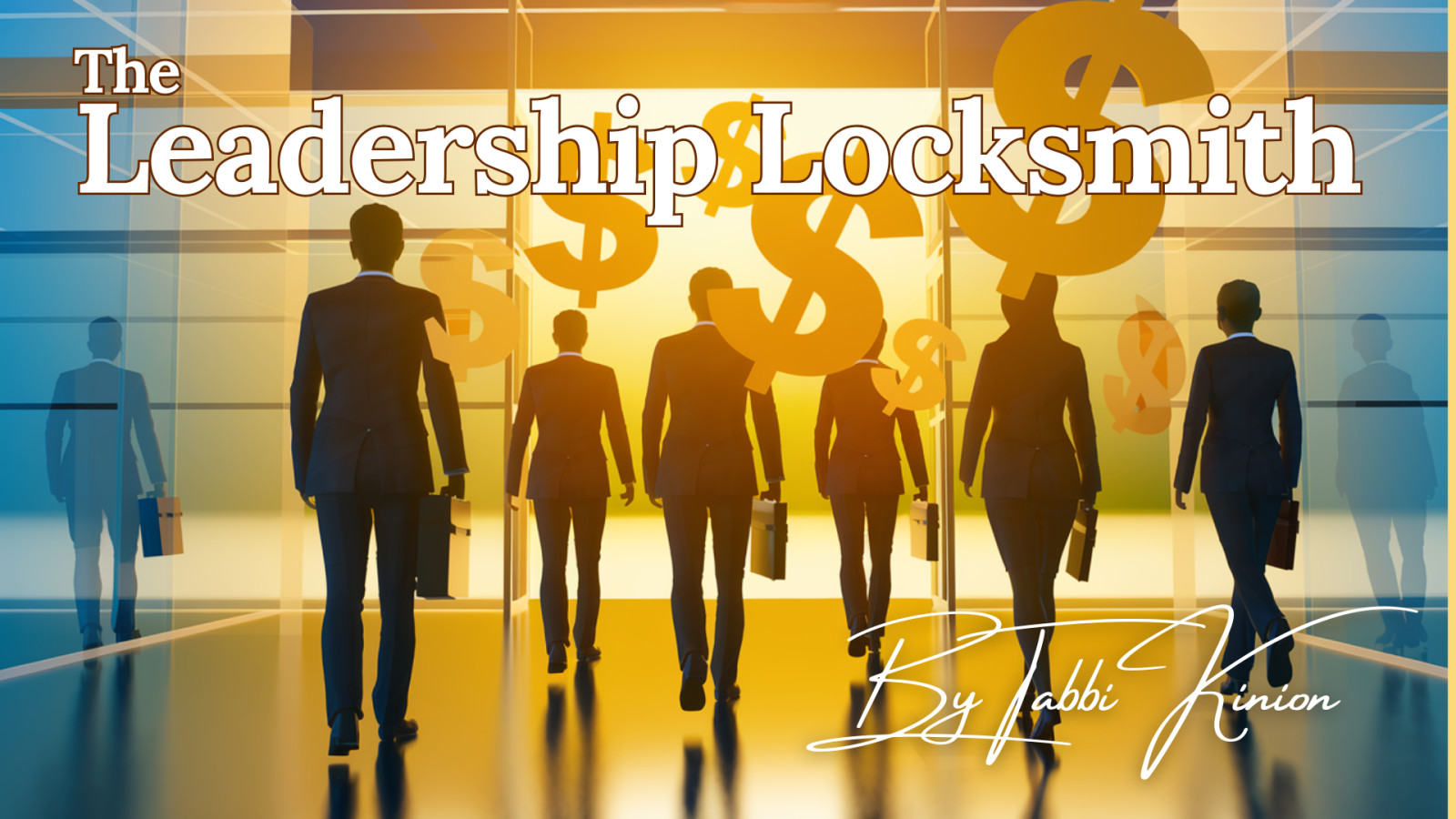
I heard some doozies from exhausted leaders this week:
"No one in this generation wants to work anymore!"
"I can't keep anyone more than a few months before they jump ship."
"People just job hop constantly now—it's what they do."
"Haven't had an employee last a whole year."
Sound familiar? If you're nodding along, your organization isn't just stuck on the hiring merry-go-round—it's watching precious dollars vanish with every resignation letter.
When I hear statements like these, my leadership coach heart doesn't just sink—it sees dollar signs flying out the window. These aren't just casual observations; they're expensive warning signals of a communication breakdown draining thousands of dollars from your organization with each resignation letter.
Let me be straight with you (because after 20+ years as a manager, I've earned the right to be blunt): Every time your team overhears you say, "Nobody wants to work anymore," or “No one sticks around for more than a few months,” you might as well be signing their resignation letters—and writing off thousands in replacement costs.
This week's Leadership Code Word: MIRROR 🪞
Just like a mirror reflects reality without filter or flattery, let's reflect on some cold, hard numbers for a moment.
According to the Work Institute's 2020 Retention Report, the minimum cost of employee turnover is approximately 33% of a worker's annual salary. For many positions, Gallup research places this figure much higher—between 50-200% of annual salary, depending on role complexity and seniority. Even for entry-level employees making $15/hour ($31,200 annually), you lose at least $10,300 each time someone quits. For a $50,000 employee, you're looking at $16,500 to $100,000 walking out the door—per person! Multiply that by your turnover rate, and the figure becomes downright terrifying.
But wait, there's more! Gallup's State of the Global Workplace report reveals that the employees who stay but are disengaged cost organizations through:
- Significantly lower productivity (18% lower than average)
- Higher absenteeism (37% higher)
- Lower quality output (15% lower)
- Decreased customer metrics (10% lower customer ratings)
And what's the #1 driver of engagement? You guessed it—how leaders communicate with their teams.
The Hidden Costs of Leadership Communication
Imagine you work at a restaurant making food. The pay is standard, hours fit your life perfectly, and you genuinely enjoy cooking. What would make you quit and start new at the restaurant down the street? Easy—the people. Especially the boss who never clearly communicates expectations, treats you with respect, offers recognition, or discusses growth opportunities.
Remember that jaw-dropping statistic from the Global Leadership Report I shared in an earlier issue? Employed people are nearly as likely to name someone from work (34%) as they are to name a family member (44%) as the person who has had the most significant positive impact on their lives.
Let that sink in.
Your influence on the people working for you today rivals that of family members. That's not just power—it's a profound responsibility that demands clear, consistent communication. When you fail to communicate with respect and clarity, you're not just losing e
mployees—you're watching thousands of dollars walk out the door with each resignation.
From Conversation Landmines to Leadership Gold
Here's the good news: If you're struggling with this, you're not alone. Nearly every leader I've coached has faced some version of this challenge. The better news? This is absolutely a fixable problem, and it starts with the one thing you can control—yourself.
This week, I encourage you to pay attention to your language about your team. Write down how you describe your employees when talking to:
- Your boss
- Your colleagues
- Your friends
- Your employees themselves
Notice any discrepancies? That's where the communication breakdown begins.
Working with a coach can be transformative here because we often can't see our own communication blind spots. I've helped leaders identify their subtle language patterns that were unconsciously telling their teams, "I don't expect you to stick around"—and then watched as retention dramatically improved once those patterns shifted.
And, if you're ready to take it further, try this mindset shift: Start communicating with your team as if each person carries the irreplaceable keys to your success.
In reality, each employee walks around with thousands of dollars in training investment, invaluable institutional knowledge, vital customer relationships, and pieces of your culture that can't be quantified on a balance sheet.
Notice how your words change when you view your team not as replaceable parts but as essential keepers of your organization's past, present, and future—human beings whose value extends far beyond the staggering financial cost of replacing them.
Ready to transform your communication approach and stop the exodus? Book a leadership game plan session, and let's get started.

I thought I was crushing it. A full-time job and a graduate school program perfectly aligned with my work - I was the poster child for career dedication. My evenings? Filled with coursework and projects that were connected to my job. Weekends? More of the same. My friends, family, and hobbies? Well, I missed them. But, I loved what I was doing so much that the line between work and study blurred into one endless loop of productivity with little time to miss out on the other things that made me... well, me.
But here's the plot twist you probably saw coming a mile away: By graduation, I wasn't just tired - I was completely burned out. Within months after graduation, I left a job I had once truly loved because I had nothing left to give. What I needed then (but didn't know it) was a coach to help me create sustainable success strategies. Someone to challenge my "more is more" mindset and help me design a better way to create balance in my leadership. And someone to help me create a recovery plan to get me back to the place where I loved my work and still had a life away from the job.
That burnout experience revolutionized my approach to leadership: Work-life harmony isn't a perk - it's a survival skill. I started my next role (a bigger position with more responsibilities) with boundaries as solid as bank vault security. Why? Because I'd learned the hard way that sustainable leadership requires sustainable practices. And I never, ever want to feel burnout like that again. Now, I get to show other leaders how to achieve more by doing less - and actually enjoy their lives along the way.
Here's the thing - my story isn't unique. And unfortunately, for many of us, it is all too common. In 2021, the World Health Organization released findings that should make every workaholic sit up straight: Working more than 55 hours per week is now the leading occupational hazard. Let that sink in. We're not just talking about being tired - we're talking about 745,000 deaths in 2016 from stroke and heart disease related to overwork.
Still thinking about checking those emails at 9 PM? Consider this:
- Your stroke risk jumps 35% when working over 55 hours
- Heart disease risk increases 17%
- Men are particularly vulnerable (72% of cases)
Those extra hours? They're probably wasted anyway. Stanford research showed that output at 70 hours barely differed from 56 hours. Those extra 14 hours? They are just expensive window-dressing.
🔑 Leadership Code Word of the Week: RECHARGE
Because let's face it - you can't pour from an empty cup, and your leadership battery needs regular charging to keep your strategic superpowers at full strength. Here are four proven strategies I use with my coaching clients to help them maximize impact while minimizing burnout:
- Conduct Your Hours Audit: Track every working hour this week (including those "quick" evening email checks). Be ruthlessly honest. Why? Because awareness drives change. When you see those hours in black and white, it becomes harder to justify that "just one more thing" mindset. Plus, research shows your cognitive function drops significantly after 50 hours of work. Want to make better decisions? Start by knowing where your time really goes.
- Delegate Like Your Health Depends On It (Because It Does): Choose three tasks to hand off this week. Yes, your team might tackle them differently - that's actually a good thing! When you trust others with meaningful work, two amazing things happen: they grow stronger, and you free up mental space for true leadership. Feeling unsure about what to delegate or how to let go? That's where leadership coaching makes all the difference. We help you develop the confidence and skills to know exactly when and what to hand off to your talented team.
- Set Your Non-Negotiable Boundary: Choose one firm limit - like no email after 6 PM or protecting your lunch break. Stick to it like it's mandated by law. When you respect your own boundaries, you model healthy work habits for your team. Plus, you'll show up fresher, sharper, and more creative. Those breakthrough solutions rarely come when you're running on empty.
- Schedule Joy (And Guard It Fiercely): Block time for something that energizes you - exercise, family dinner, a hobby - and defend it like you would a crucial stakeholder meeting. Why? Because you are a crucial stakeholder in your own success. Leaders who maintain interests outside work bring fresh perspectives and increased resilience to their roles. Your team needs you energized, not exhausted.
Remember: Every hour you reclaim isn't just an investment in your well-being - it's an investment in your leadership effectiveness. Your team deserves a leader who's present, focused, and modeling sustainable success.
Ready to unlock your leadership potential without sacrificing your sanity? Let's connect! Connect with me for more practical wisdom on leading without losing yourself in the process!
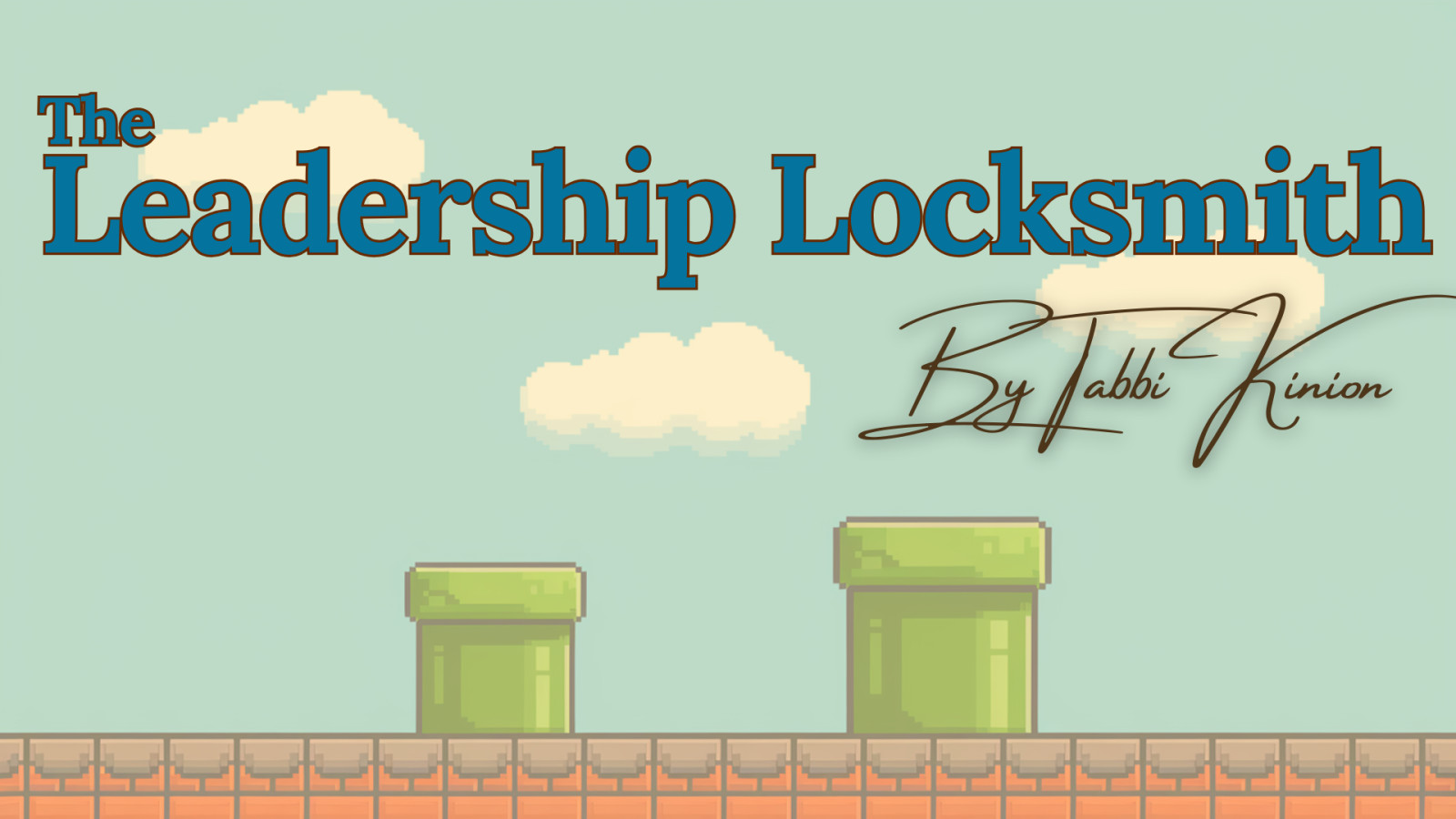
Full disclosure: I was terrible at Super Mario Brothers. Like, embarrassingly bad. I'd regularly fall into pits, get knocked out by the slowest-moving Goombas, and my timing on those jumping sequences? Let's just say Princess Peach wasn't counting on me for rescue. I never made it that far.
But here's the thing - I kept playing anyway. Even though I was terrible, I memorized every hidden block and power-up location in World 1-1 through sheer persistence. Because while I may not be a natural gamer, I discovered something crucial: the path to success, whether in Mario Brothers or leadership, follows the same pattern. You start small, gather new abilities, learn from those face-palm moments, and gradually level-up to bigger challenges.
In the game, tiny Mario hunts for mushrooms to grow bigger, grabs fire flowers for new abilities, and collects stars for temporary invincibility. Each power-up transforms his capabilities for tougher challenges ahead. Leadership works the same way - though thankfully, there's less chance of being eaten by piranha plants. It's not about being perfect; it's about being persistent and knowing when you need that next power-up.
That's exactly what was on my mind last week when a client confided in our coaching session: "I've hit my leadership plateau. I climbed here through technical expertise, but now I'm facing challenges no amount of policy knowledge can solve." I knew exactly what they meant - they were like Mario stuck in small form trying to battle Bowser, technically in the game but critically underpowered for the level they were trying to play.
Here's why this matters:
According to McLean & Company's 2024 Future of Work Report, leadership skill sets will need to "change completely or almost completely" by 2030. That's not a typo - completely. The leadership game is being rewritten, and we need new power-ups to stay competitive.
The research reveals some eye-opening trends:
- 71% of professionals aged 18-29 would take a 10% pay cut to work for an organization creating positive social impact
- Traditional career paths are dissolving as workers prioritize work-life balance and role enjoyment
- Technical skills have a shorter shelf life than durable skills like analytical thinking and emotional intelligence
- Organizations are shifting toward skills-based models rather than rigid position descriptions
And here's where it gets even more interesting - Gallup's latest Global Leadership Report reveals what your team is really looking for in their leadership power-ups. Just like Mario needs specific power-ups for different challenges, your team needs four essential elements from you: hope, trust, compassion, and stability.
Here's the game-changer: Hope isn't just a nice-to-have power-up - it's the superstar of leadership abilities. A whopping 56% of attributes linked to influential leaders revolve around hope, leaving trust (33%) in second place. Think about that - hope is literally more powerful than trust!
And for all my leaders of young employees out there, this is especially crucial for your Gen Z team members. The data shows that 18-29-year-olds are particularly hungry for hope-focused leadership. (Remember that 71% who'd take a pay cut for meaningful work? They're looking for leaders who can paint a picture of positive impact!)
But here's the really wild part - your leadership power-ups have more impact than you might think. Gallup found that workplace leaders have almost as much influence on people's lives as family members (34% vs 44%). That's right - your leadership style isn't just affecting quarterly goals; it's literally shaping people's life satisfaction.
This week's leadership code: POWER-UP MINDSET 🌟
Just like Mario's power-ups multiply his abilities, each new leadership skill you gain expands your capacity to navigate these changes. But here's the twist - unlike Mario, you can't just stumble upon these power-ups. You need to seek them out actively.
Early in my career, I thought leadership meant:
🤦Doing Everything Myself - "If you want something done right..." (Plot twist: Delegation actually makes everything better!)
🔄 Saying Yes to Everything - My calendar looked like a game of Tetris gone wrong. (Proud graduate of People-Pleasers Anonymous now!)
⏰Working 50+ hour weeks was my norm - That one month with only two days off? Let's file that under "Lessons Learned the Hard Way."
🙈 Avoiding Tough Conversations - My conflict management strategy? Hope it magically disappears! (Spoiler alert: It never did.)
📚 Neglecting My Own Growth - To my early-career team members: I owe you a coffee and a massive apology for learning leadership on the job!
Sound familiar? Don't worry - we've all been there. These aren't just confessions; they're battle scars that turned into wisdom. And now? They're exactly what NOT to do in your leadership journey!
Today's leaders need different power-ups
The Essential Four (According to Gallup):
⭐ Hope Power-Up (Your Star Power): The most crucial ability, driving 38% higher team thriving. Create an inspiring vision that gives work meaning.
🔥 Trust Power-Up (Your Fire Flower): Build credibility through consistent, transparent leadership - it's 33% of your leadership impact.
🍄 Compassion Power-Up (Your Super Mushroom): Create psychological safety where people feel valued and understood.
🛡️ Stability Power-Up (Your Shield): Provide clear direction and reliable support in a changing world.
But knowing what power-ups you need isn't enough - you need to know how to use them effectively. Here's how to deploy these power-ups in your daily leadership:
Create conditions for strategic and creative work: Think of this as designing your team's game level. With AI handling routine tasks, your role is to create space for innovation and strategic thinking. This means fewer status meetings and more brainstorming sessions, less micromanaging, and more empowerment.
Foster meaningful technology engagement: It's not enough to just have the latest tools - you need to be the bridge between human potential and technological capability. Like choosing the right power-up for each challenge, help your team leverage technology to enhance, not replace, their work.
Build psychological safety and belonging: Consider this your team's shield power-up. When people feel safe to take risks, share ideas, and be themselves at work, they perform at their best. Create an environment where mistakes are learning opportunities and diverse perspectives are actively sought.
Develop both technical and durable skills: Technical skills are like temporary power-ups - useful but time-limited. Durable skills (critical thinking, emotional intelligence, adaptability) are your permanent upgrades. Your team needs both to thrive in 2025 and beyond.
Manage diverse, multi-generational teams: Your workforce spans from Gen Z to Boomers, each with different motivations and work styles. Like a game requiring different strategies for different opponents, effective leaders adapt their approach while maintaining equity and inclusion.
Prioritize wellbeing and connection: This is your team's energy bar. McLean & Company's research shows that well-being isn't just about work-life balance - it's about creating meaningful connections and ensuring people feel valued. When the energy bar is full, everything works better.
The multiplier effect?
When you prioritize your own growth, you create ripples far beyond your immediate team. Remember that wild Gallup stat - your leadership influence is nearly equal to family members in shaping people's lives! By modeling continuous learning and deploying those essential power-ups (hope, trust, compassion, and stability), you're not just prepping your team for McLean's predicted 2030 leadership revolution - you're actively improving their whole life experience.
Think of it like throwing a Super Star in Mario - the invincibility spreads beyond just Mario to transform the whole game. When you show up as a powered-up leader, you create:
- A hope-filled vision of the future (that 56% leadership superpower!)
- Space for innovation and strategic thinking (crucial for McLean's 2030 forecast)
- Permission for others to prioritize their own growth and well-being
It's not just about leveling up yourself - it's about creating an environment where everyone can thrive. That's true leadership multiplication! 🌟
Your Next Power-Up Move: 🎮
Take a hard look at your current leadership approach. Are you still playing on basic mode when you could be Fire Mario? The future of work demands leaders who can adapt, grow, and create meaningful impact.
Remember: Every great leader was once just like Mario at the start of World 1-1. The difference? They kept collecting those power-ups.⭐
Feeling stuck in Small Mario mode? Your next leadership level awaits. Email me "POWER-UP"🔥 to discover how the Leadership Locksmith System can help you level up your leadership game while reclaiming your life outside of work.
